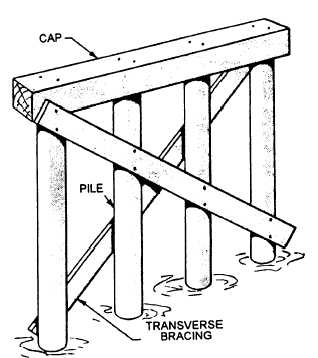consists of two or more rows of posts or piles. The
Figure 1-3.—Typical pile bent.
INTERMEDIATE SUPPORTS
Bents and piers provide support for the bridge
superstructure at points other than the bank ends. A bent
consists of a single row of posts or piles, while a pier
following text discusses some of the different types of
bents and piers.
The pile bent shown in figure 1-3 consists of the
bent cap, which provides a bearing surface for the bridge
stringers, and the piles, which transmit the load to the
soil. The support for the loads may be derived either
from column action when the tip of the pile bears on
firm stratum, such as rock or hard clay, or from friction
between the pile and the soil into which it is driven. In
both cases, earth pressure must provide some lateral
support, but traverse bracing is often used to brace the
bent laterally.
A timber pile bent consists of a single row of piles
with a pile cap. It should be braced to the next bent or
to an abutment to reduce the unbraced length and to
provide stability. This bent will support a combined span
length of 50 feet
The trestle bent shown in figure 1-4 is similar to the
pile bent except that the posts, taking the place of the
piles, transmit the load from the cap to the sill. The sill
transmits the load to the footings, and the footings
transmit the load to the soil. Timber trestle bents are
normally constructed in dry, shallow gaps in which the
soil is firm. They are not suitable for use in soft soil or
swift or deep streams. The bent can support a combined
span length of up to 30 feet and can be 12 feet high.
Figure 1-4.—Timber trestle bent.
1-3










